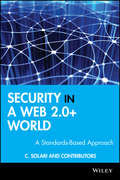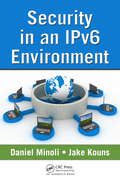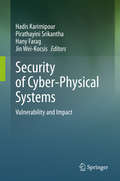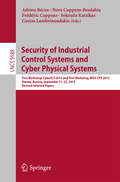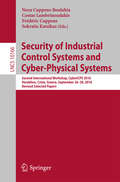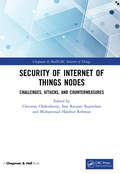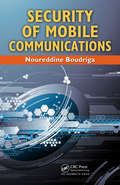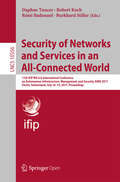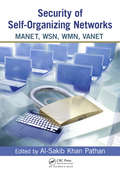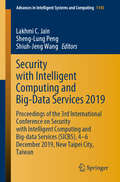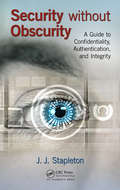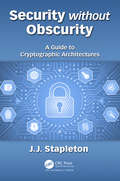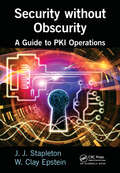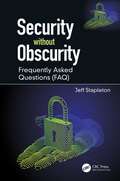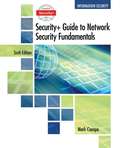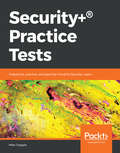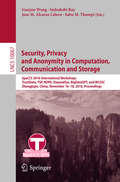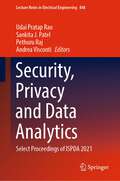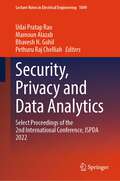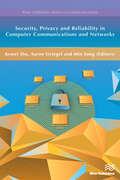- Table View
- List View
Security in a Web 2.0+ World
by Carlos Curtis SolariDiscover how technology is affecting your business, and why typical security mechanisms are failing to address the issue of risk and trust.Security for a Web 2.0+ World looks at the perplexing issues of cyber security, and will be of interest to those who need to know how to make effective security policy decisions to engineers who design ICT systems - a guide to information security and standards in the Web 2.0+ era. It provides an understanding of IT security in the converged world of communications technology based on the Internet Protocol.Many companies are currently applying security models following legacy policies or ad-hoc solutions. A series of new security standards (ISO/ITU) allow security professionals to talk a common language. By applying a common standard, security vendors are able to create products and services that meet the challenging security demands of technology further diffused from the central control of the local area network. Companies are able to prove and show the level of maturity of their security solutions based on their proven compliance of the recommendations defined by the standard.Carlos Solari and his team present much needed information and a broader view on why and how to use and deploy standards. They set the stage for a standards-based approach to design in security, driven by various factors that include securing complex information-communications systems, the need to drive security in product development, the need to better apply security funds to get a better return on investment.Security applied after complex systems are deployed is at best a patchwork fix. Concerned with what can be done now using the technologies and methods at our disposal, the authors set in place the idea that security can be designed in to the complex networks that exist now and for those in the near future. Web 2.0 is the next great promise of ICT - we still have the chance to design in a more secure path.Time is of the essence - prevent-detect-respond!
Security in an IPv6 Environment
by Jake Kouns Daniel MinoliAnalyze Key Security Mechanisms and Approaches with this practical primer, the first book on the market to cover critical IPv6 security considerations.Dan Minoli, author of over 50 books on telecommunications and networks, and Jake Kouns, Chairman, CEO and CFO of the Open Security Foundation, discuss IPv6 security vulnerabilities, considerations, a
Security in the Private Cloud
by John R. VaccaThis comprehensive handbook serves as a professional reference and practitioner’s guide to today’s most complete and concise view of private cloud security. It explores practical solutions to a wide range of private cloud computing security issues. The knowledge imparted will enable readers to determine whether the private cloud security solution is appropriate for their organization from a business and technical perspective, to select the appropriate cloud security model, and to plan and implement a cloud security adoption and migration strategy.
Security of Cyber-Physical Systems: Vulnerability and Impact
by Hadis Karimipour Pirathayini Srikantha Hany Farag Jin Wei-KocsisThis book presents a comprehensive overview of security issues in Cyber Physical Systems (CPSs), by analyzing the issues and vulnerabilities in CPSs and examining state of the art security measures. Furthermore, this book proposes various defense strategies including intelligent attack and anomaly detection algorithms.Today’s technology is continually evolving towards interconnectivity among devices. This interconnectivity phenomenon is often referred to as Internet of Things (IoT). IoT technology is used to enhance the performance of systems in many applications. This integration of physical and cyber components within a system is associated with many benefits; these systems are often referred to as Cyber Physical Systems (CPSs).The CPSs and IoT technologies are used in many industries critical to our daily lives. CPSs have the potential to reduce costs, enhance mobility and independence of patients, and reach the body using minimally invasive techniques. Although this interconnectivity of devices can pave the road for immense advancement in technology and automation, the integration of network components into any system increases its vulnerability to cyber threats. Using internet networks to connect devices together creates access points for adversaries. Considering the critical applications of some of these devices, adversaries have the potential of exploiting sensitive data and interrupting the functionality of critical infrastructure.Practitioners working in system security, cyber security & security and privacy will find this book valuable as a reference. Researchers and scientists concentrating on computer systems, large-scale complex systems, and artificial intelligence will also find this book useful as a reference.
Security of Industrial Control Systems and Cyber Physical Systems
by Adrien Bécue Nora Cuppens-Boulahia Frédéric Cuppens Sokratis Katsikas Costas LambrinoudakisThis book constitutes the refereed proceedings of the First Conference on Cybersecurity of Industrial Control Systems, CyberICS 2015, and the First Workshop on the Security of Cyber Physical Systems, WOS-CPS 2015, held in Vienna, Austria, in September 2015 in conjunction with ESORICS 2015, the 20th annual European Symposium on Research in Computer Security. The 6 revised full papers and 2 short papers of CyberICS 2015 presented together with 3 revised full papers of WOS-CPS 2015 were carefully reviewed and selected from 28 initial submissions. CyberICS 2015 focuses on topics covering ICSs, including cyber protection and cyber defense of SCADA systems, plant control systems, engineering workstations, substation equipment, programmable logic controllers, PLCs, and other industrial control system. WOS-CPS 2015 deals with the Security of Cyber Physical Systems, that exist everywhere around us, and range in size, complexity and criticality, from embedded systems used in smart vehicles, to SCADA systems in smart grids to control systems in water distribution systems, to smart transportation systems etc.
Security of Industrial Control Systems and Cyber-Physical Systems
by Nora Cuppens-Boulahia Frédéric Cuppens Sokratis Katsikas Costas LambrinoudakisThis book constitutes the refereed proceedings of the First Conference on Cybersecurity of Industrial Control Systems, CyberICS 2015, and the First Workshop on the Security of Cyber Physical Systems, WOS-CPS 2015, held in Vienna, Austria, in September 2015 in conjunction with ESORICS 2015, the 20th annual European Symposium on Research in Computer Security. The 6 revised full papers and 2 short papers of CyberICS 2015 presented together with 3 revised full papers of WOS-CPS 2015 were carefully reviewed and selected from 28 initial submissions. CyberICS 2015 focuses on topics covering ICSs, including cyber protection and cyber defense of SCADA systems, plant control systems, engineering workstations, substation equipment, programmable logic controllers, PLCs, and other industrial control system. WOS-CPS 2015 deals with the Security of Cyber Physical Systems, that exist everywhere around us, and range in size, complexity and criticality, from embedded systems used in smart vehicles, to SCADA systems in smart grids to control systems in water distribution systems, to smart transportation systems etc.
Security of Internet of Things Nodes: Challenges, Attacks, and Countermeasures (Chapman & Hall/CRC Internet of Things)
by Chinmay ChakrabortyThe book Security of Internet of Things Nodes: Challenges, Attacks, and Countermeasures® covers a wide range of research topics on the security of the Internet of Things nodes along with the latest research development in the domain of Internet of Things. It also covers various algorithms, techniques, and schemes in the field of computer science with state-of-the-art tools and technologies. This book mainly focuses on the security challenges of the Internet of Things devices and the countermeasures to overcome security vulnerabilities. Also, it highlights trust management issues on the Internet of Things nodes to build secured Internet of Things systems. The book also covers the necessity of a system model for the Internet of Things devices to ensure security at the hardware level.
Security of Mobile Communications
by Noureddine BoudrigaThe explosive demand for mobile communications is driving the development of wireless technology at an unprecedented pace. Unfortunately, this exceptional growth is also giving rise to a myriad of security issues at all levels-from subscriber to network operator to service provider. Providing technicians and designers with a critical and comprehens
Security of Networks and Services in an All-Connected World: 11th IFIP WG 6.6 International Conference on Autonomous Infrastructure, Management, and Security, AIMS 2017, Zurich, Switzerland, July 10-13, 2017, Proceedings (Lecture Notes in Computer Science #10356)
by Rémi Badonnel Robert Koch Burkhard Stiller Daphne TuncerThis book is open access under a CC BY 4. 0 license. This book constitutes the refereed proceedings of the 11th IFIP WG 6. 6 International Conference on Autonomous Infrastructure, Management, and Security, AIMS 2017, held in Zurich, Switzerland, in July 2017. The 8 full papers presented together with 11 short papers were carefully reviewed and selected from 24 submissions. The papers are organized in the following topical sections: security management; management of cloud environments and services, evaluation and experimental study of rich network services; security, intrusion detection, and configuration; autonomic and self-management solutions; and methods for the protection of infrastructure.
Security of Self-Organizing Networks: MANET, WSN, WMN, VANET
by AI-Sakib Khan PathanReflecting recent advancements, Security of Self-Organizing Networks: MANET, WSN, WMN, VANET explores wireless network security from all angles. It begins with a review of fundamental security topics and often-used terms to set the foundation for the following chapters. Examining critical security issues in a range of wireless networks, the bo
Security of Ubiquitous Computing Systems: Selected Topics
by Gildas Avoine Julio Hernandez-CastroThe chapters in this open access book arise out of the EU Cost Action project Cryptacus, the objective of which was to improve and adapt existent cryptanalysis methodologies and tools to the ubiquitous computing framework. The cryptanalysis implemented lies along four axes: cryptographic models, cryptanalysis of building blocks, hardware and software security engineering, and security assessment of real-world systems.The authors are top-class researchers in security and cryptography, and the contributions are of value to researchers and practitioners in these domains.This book is open access under a CC BY license.
Security with Go: Explore the power of Golang to secure host, web, and cloud services
by John Daniel LeonThe first stop for your security needs when using Go, covering host, network, and cloud security for ethical hackers and defense against intrusion Key Features First introduction to Security with Golang Adopting a Blue Team/Red Team approach Take advantage of speed and inherent safety of Golang Works as an introduction to security for Golang developers Works as a guide to Golang security packages for recent Golang beginners Book Description Go is becoming more and more popular as a language for security experts. Its wide use in server and cloud environments, its speed and ease of use, and its evident capabilities for data analysis, have made it a prime choice for developers who need to think about security. Security with Go is the first Golang security book, and it is useful for both blue team and red team applications. With this book, you will learn how to write secure software, monitor your systems, secure your data, attack systems, and extract information. Defensive topics include cryptography, forensics, packet capturing, and building secure web applications. Offensive topics include brute force, port scanning, packet injection, web scraping, social engineering, and post exploitation techniques. What you will learn Learn the basic concepts and principles of secure programming Write secure Golang programs and applications Understand classic patterns of attack Write Golang scripts to defend against network-level attacks Learn how to use Golang security packages Apply and explore cryptographic methods and packages Learn the art of defending against brute force attacks Secure web and cloud applications Who this book is for Security with Go is aimed at developers with basics in Go to the level that they can write their own scripts and small programs without difficulty. Readers should be familiar with security concepts, and familiarity with Python security applications and libraries is an advantage, but not a necessity.
Security with Intelligent Computing and Big-Data Services 2019: Proceedings of the 3rd International Conference on Security with Intelligent Computing and Big-data Services (SICBS), 4–6 December 2019, New Taipei City, Taiwan (Advances in Intelligent Systems and Computing #1145)
by Lakhmi C. Jain Sheng-Lung Peng Shiuh-Jeng WangThis book aims to attract researchers and practitioners who are working in Information Technology and Computer Science. This edited book is about basics and high level concepts regarding Blockchain Technology and Application, Multimedia Security, Information Processing, Security of Network, Cloud and IoT, Cryptography and Cryptosystem, Learning and Intelligent Computing, Information Hiding. It is becoming increasingly important to develop adaptive, intelligent computing-centric, energy-aware, secure and privacy-aware mechanisms in high performance computing and IoT applications. The book serves as a useful guide for industry persons and also helps beginners to learn things from basic to advance in the area of better computing paradigm. Our aim is intended to provide a platform for researchers, engineers, academicians as well as industrial professionals from all over the world to present their research results in security related areas. We believe that this volume not only presents novel and interesting ideas but also will stimulate interesting discussions from the participants and inspire new ideas.
Security with Intelligent Computing and Big-data Services
by Valentina Emilia Balas Sheng-Lung Peng Shiuh-Jeng Wang Ming ZhaoIn the dawning era of Intelligent Computing and Big-data Services, security issues will be an important consideration in promoting these new technologies into the future. This book presents the proceedings of the 2017 International Conference on Security with Intelligent Computing and Big-data Services, the Workshop on Information and Communication Security Science and Engineering, and the Workshop on Security in Forensics, Medical, and Computing Services and Applications. The topics addressed include: Algorithms and Security Analysis, Cryptanalysis and Detection Systems, IoT and E-commerce Applications, Privacy and Cloud Computing, Information Hiding and Secret Sharing, Network Security and Applications, Digital Forensics and Mobile Systems, Public Key Systems and Data Processing, and Blockchain Applications in Technology. The conference is intended to promote healthy exchanges between researchers and industry practitioners regarding advances in the state of art of these security issues. The proceedings not only highlight novel and interesting ideas, but will also stimulate interesting discussions and inspire new research directions.
Security with Intelligent Computing and Big-data Services: Proceedings of the Second International Conference on Security with Intelligent Computing and Big Data Services (SICBS-2018) (Advances in Intelligent Systems and Computing #895)
by Lakhmi C. Jain Ching-Nung Yang Sheng-Lung PengThis book presents the proceedings of the 2018 International Conference on Security with Intelligent Computing and Big-data Services (SICBS 2018). With the proliferation of security with intelligent computing and big-data services, the issues of information security, big data, intelligent computing, blockchain technology, and network security have attracted a growing number of researchers. Discussing topics in areas including blockchain technology and applications; multimedia security; information processing; network, cloud and IoT security; cryptography and cryptosystems; as well as learning and intelligent computing and information hiding, the book provides a platform for researchers, engineers, academics and industrial professionals from around the globe to present their work in security-related areas. It not only introduces novel and interesting ideas, but also stimulates discussions and inspires new ideas.
Security without Obscurity: A Guide to Confidentiality, Authentication, and Integrity
by J.J. StapletonThe traditional view of information security includes the three cornerstones: confidentiality, integrity, and availability; however the author asserts authentication is the third keystone. As the field continues to grow in complexity, novices and professionals need a reliable reference that clearly outlines the essentials. Security without Obscurit
Security without Obscurity: A Guide to Cryptographic Architectures
by Jeff StapletonInformation security has a major gap when cryptography is implemented. Cryptographic algorithms are well defined, key management schemes are well known, but the actual deployment is typically overlooked, ignored, or unknown. Cryptography is everywhere. Application and network architectures are typically well-documented but the cryptographic architecture is missing. This book provides a guide to discovering, documenting, and validating cryptographic architectures. Each chapter builds on the next to present information in a sequential process. This approach not only presents the material in a structured manner, it also serves as an ongoing reference guide for future use.
Security without Obscurity: A Guide to PKI Operations
by Jeff Stapleton W. Clay EpsteinMost books on public key infrastructure (PKI) seem to focus on asymmetric cryptography, X.509 certificates, certificate authority (CA) hierarchies, or certificate policy (CP), and certificate practice statements. While algorithms, certificates, and theoretical policy are all excellent discussions, the real-world issues for operating a commercial or
Security without Obscurity: Frequently Asked Questions (FAQ)
by Jeff StapletonSecurity without Obscurity: Frequently Asked Questions (FAQ) complements Jeff Stapleton’s three other Security without Obscurity books to provide clear information and answers to the most commonly asked questions about information security (IS) solutions that use or rely on cryptography and key management methods. There are good and bad cryptography, bad ways of using good cryptography, and both good and bad key management methods. Consequently, information security solutions often have common but somewhat unique issues. These common and unique issues are expressed as an FAQ organized by related topic areas. The FAQ in this book can be used as a reference guide to help address such issues. Cybersecurity is based on information technology (IT) that is managed using IS controls, but there is information, misinformation, and disinformation. Information reflects things that are accurate about security standards, models, protocols, algorithms, and products. Misinformation includes misnomers, misunderstandings, and lack of knowledge. Disinformation can occur when marketing claims either misuse or abuse terminology, alluding to things that are inaccurate or subjective. This FAQ provides information and distills misinformation and disinformation about cybersecurity. This book will be useful to security professionals, technology professionals, assessors, auditors, managers, and hopefully even senior management who want a quick, straightforward answer to their questions. It will serve as a quick reference to always have ready on an office shelf. As any good security professional knows, no one can know everything.
Security+ Guide To Network Security Fundamentals (Sixth Edition)
by Mark CiampaComprehensive, practical, and completely up to date, best-selling COMPTIA SECURITY+ GUIDE TO NETWORK SECURITY FUNDAMENTALS, 6e, provides a thorough introduction to network and computer security that prepares you for professional certification and career success. Mapped to the new CompTIA Security+ SY0-501 Certification Exam, the text provides comprehensive coverage of all domain objectives. The sixth edition also includes expansive coverage of embedded device security, attacks and defenses, and the latest developments and trends in information security, including new software tools to assess security.
Security+® Practice Tests: Prepare for, practice, and pass the CompTIA Security+ exam
by Mike ChappleAce the CompTIA Security+ exam with over 700 practice exam questions written using the style and format of the Security+ exam Key Features Get a detailed breakdown of the type of questions and the exam environment Discover a step-by-step process that guides you through the study process week-by-week Reinforce your learning by solving 100 questions for each domain Book Description Security+ certification is the most popular entry-level certification for cybersecurity professionals. It has no work experience requirement, making it accessible to everyone willing to put in the time to prepare for the exam. Security+? Practice Tests are the perfect tools to prepare for the CompTIA Security+ exam. The first six chapters each cover one of the six Security+ domains. Each of those chapters contains around 100 practice test questions covering the material from that domain. The last two chapters each contain a full-length Security+ practice test that's designed to assess your readiness to take the actual test. At the end of each chapter, you'll find the answers to all of the questions along with detailed explanations to help reinforce your learning of the material. By the end of the book, you'll have enough practice to easily ace the CompTIA Security+ exam. What you will learn Familiarize yourself with the format of the Security+ exam Target your test preparation on each of the Security+ domains Brush up on your understanding by testing yourself on realistic practice questions Discover areas for improvement by comparing your responses to the answers provided Measure your readiness with full-length practice tests Know what to expect on test day and Learn helpful strategies for tackling the different question types Who this book is for This book is designed for service desk analysts, system support engineers, and other IT professionals who want to start their career in managing the IT infrastructure of an organization. Basic knowledge of hardware, software, other relevant components of the IT industry will help you easily grasp the concepts explained in this book.
Security, Privacy and Anonymity in Computation, Communication and Storage
by Jose M. Alcaraz Calero Sabu M. Thampi Guojun Wang Indrakshi RayThis book constitutes the refereed proceedings of the 9th International Conference on on Security, Privacy and Anonymity in Computation, Communication and Storage, SpaCCS 2016, held in Zhangjiajie, China, in November 2016. The 40 papers presented in this volume were carefully reviewed and selected from 110 submissions. They are organized in topical sections including security algorithms and architectures, privacy-aware policies, regulations and techniques, anonymous computation and communication, encompassing fundamental theoretical approaches, practical experimental projects, and commercial application systems for computation, communication and storage.
Security, Privacy and Data Analytics: Select Proceedings of ISPDA 2021 (Lecture Notes in Electrical Engineering #848)
by Pethuru Raj Udai Pratap Rao Sankita J. Patel Andrea ViscontiThis book constitutes refereed proceedings of the International Conference on Security, Privacy and Data Analytics, ISPDA 2021. The volume covers a wide range of topics, including big data and analytics, cloud security and privacy, data intelligence, hardware security, network security, blockchain technology and distributed ledger, machine learning for security, and many others. The volume includes novel contributions and the latest developments from researchers across industry and academia working in security, privacy, and data analytics from technological and social perspectives. The book will serve as a valuable reference resource for academics and researchers across the globe.
Security, Privacy and Data Analytics: Select Proceedings of the 2nd International Conference, ISPDA 2022 (Lecture Notes in Electrical Engineering #1049)
by Pethuru Raj Chelliah Mamoun Alazab Udai Pratap Rao Bhavesh N. GohilThis book constitutes refereed proceedings of the International Conference on Security, Privacy and Data Analytics, ISPDA 2022. The volume covers topics, including big data and analytics, cloud security and privacy, data intelligence, hardware security, network security, blockchain technology and distributed ledger, machine learning for security, and many others. The volume includes novel contributions and the latest developments from researchers across industry and academia working in security, privacy, and data analytics from technological and social perspectives. This book will emerge as a valuable reference for researchers, instructors, students, scientists, engineers, managers, and industry practitioners across the globe.
Security, Privacy and Reliability in Computer Communications and Networks
by Min Song Kewei Sha Aaron StriegelFuture communication networks aim to build an intelligent and efficient living environment by connecting a variety of heterogeneous networks to fulfill complicated tasks. These communication networks bring significant challenges in building secure and reliable communication networks to address the numerous threat and privacy concerns. New research technologies are essential to preserve privacy, prevent attacks, and achieve the requisite reliability. Security, Privacy and Reliability in Computer Communications and Networks studies and presents recent advances reflecting the state-of-the-art research achievements in novel cryptographic algorithm design, intrusion detection, privacy preserving techniques and reliable routing protocols. Technical topics discussed in the book include: Vulnerabilities and Intrusion DetectionCryptographic Algorithms and EvaluationPrivacyReliable Routing ProtocolsThis book is ideal for personnel in computer communication and networking industries as well as academic staff and collegial, master, Ph.D. students in computer science, computer engineering, cyber security, information insurance and telecommunication systems.
